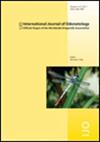迷失在时间里:两种印度特有的Elattoneura Cowley, 1935 (playcnediae)豆娘的重新描述和生态重新评估
IF 1
4区 农林科学
Q3 ENTOMOLOGY
引用次数: 1
摘要
由于其形态极其相似,而识别键和地理分布信息稀少,印度Elattoneura是一个难以识别的类群。这种模糊性在印度半岛的两个Elattoneura物种,E. nigerrima (Laidlaw, 1917)和E. tetrica (Laidlaw, 1917)中尤为突出,它们在100年前被描述过。这两个物种的描述都是基于雄性标本,缺乏关于雌性标本的信息。该物种已被IUCN列入红色名录,尼日尔河鳗(数据不足)和tetrica(最不受关注)。迄今为止,人们认为尼日利亚乳杆菌比白斑乳杆菌小,两者的地理分布不重叠。在这里,我们重新描述了尼日利亚乳杆菌的两性;以及形态计量数据和地理空间分析。我们发现尼日利亚乳杆菌明显大于tetrica乳杆菌。该物种在分布上主要是异域的,前者的空间分布比以前认为的要广泛得多。基于我们的地理空间分析,我们为未来IUCN对尼日利亚乳杆菌和虎斑乳杆菌的评估提供了有用的数据。我们强调更新分类状态信息和时空分布数据对开展豆娘等特有种昆虫的保护具有重要意义。我们的研究表明,迫切需要对印度蜥目动物进行重新评估。本文章由计算机程序翻译,如有差异,请以英文原文为准。
Lost in Time: Re-description and Ecological Re-assessment of two Indian Endemic Elattoneura Cowley, 1935 (Playcnemidiae) Damselflies
The Indian Elattoneura are a difficult group to identify due to their extreme morphological similarity and sparse information in identification keys and on geographical distribution. The ambiguity is prominent among two Peninsular Indian Elattoneura species, E. nigerrima (Laidlaw, 1917) and E. tetrica (Laidlaw, 1917), described a hundred years ago. Both species were described based on male specimens with scant information on their females. The species are IUCN Red-listed, E. nigerrima (Data Deficient) and E. tetrica (Least Concern). Hitherto it was thought that E. nigerrima was smaller than E. tetrica and both have non-overlapping geographical distribution. Here, we re-described both sexes of E. nigerrima; E. tetrica along with morphometric data and geospatial analysis. We found that E. nigerrima is significantly larger than E. tetrica. The species are largely allopatric in distribution, with the former having a much wider spatial distribution than previously thought. Based on our geospatial analysis, we provide occurrence data useful for the future IUCN assessments of E. nigerrima and E. tetrica. We highlight the importance of updating taxonomic status information and data on spatiotemporal distribution to proceed with the conservation of endemic insects such as Elattoneura damselflies. Our study indicates reassessments of Indian Odonata species are urgently needed.
求助全文
通过发布文献求助,成功后即可免费获取论文全文。
去求助
来源期刊

International Journal of Odonatology
ENTOMOLOGY-
CiteScore
2.30
自引率
0.00%
发文量
15
审稿时长
>12 weeks
期刊介绍:
International Journal of Odonatology (IJO) is aimed at providing a publication outlet for the growing number of students of Odonata. It will address subjects such as the ecology, ethology, physiology, genetics, taxonomy, phylogeny and geographic distribution of species. Reviews will be by invitation, but authors who plan to write a review on a subject of interest to the journal are encouraged to contact the editor.
 求助内容:
求助内容: 应助结果提醒方式:
应助结果提醒方式:


